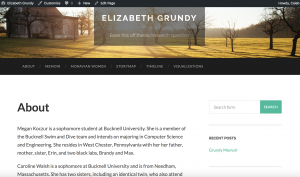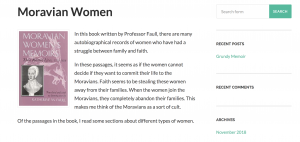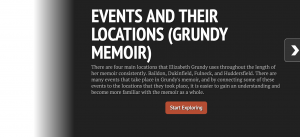http://grundyhumn100.blogs.bucknell.edu/2018/11/
After finishing up transcribing Elizabeth Grundy’s entire memoir, my group and I created a website through WordPress which gave us the freedom to customize the setup of our site. Our group chose to divide the website into six main sections regarding Elizabeth Grundy, as well as all of the work that we put into analyzing her memoir. The first section is the “About” section, where me and the three of my group members all write a short bio about themselves so people are familiar with who we are and where we are from. The second section is titled “Memoir”, and it is a very brief summary of what happens throughout the Elizabeth Grundy memoir. Third we have “Moravian Women”, which offers up some examples of married and non-married Moravian women who struggle between balancing out faith and family. This is actually what inspired our group’s research question, and made us want to find out whether or not there were different relationships between allegiance to family and allegiance to the church in Moravian lives. The next of the six sections is titled “StoryMap”, followed by “Timeline”, and “Visualizations.” For the StoryMap tab my group and I explained the process we used to create our StoryMaps, as well as why they were beneficial to understanding our memoir. The “Timeline” tab is going to be used as a more brief StoryMap, or a short summary of events that occur throughout Grundy’s memoir. Finally, the “Visualizations” is going to be the section where my group and I post screenshots that we have taken of either our website, or anything we have used to help us analyze Elizabeth Grundy’s memoir.

This is to give you an idea of what our website looks like, and how we chose to organize our data. The about section is very brief and is just meant to familiarize the audience with everyone in our group. One of the most useful pieces of data we were able to gain access to, is a book that was written by Professor Faull called Moravian Women’s Memoirs. It speaks on the lives of multiple different single as well as married Moravian women, and the difficulty of managing both your family relationships, and your relationship to the church/God. A large majority of these women would completely abandon their families to live their lives as member of a certain church congregation, which tells us that these Moravian churches were very persuasive and had a lot to offer Moravian women.

I was in charge of putting together the “Timeline” section of our website, so I started off by going back to my StoryMap that I created relating events in the memoir to the locations that they occurred. These events and their locations add to the analysis of this memoir by allowing us to see it from a geographical point of view. “Graphic representation is among our most important tools for organizing information”(Grafton 10). Reading a memoir is one thing, but representing themes, ideas and events from the same memoir graphically/geographically, allows us to get a better feel for what was going on in the writing. Combining event and locations, “will allow us to fuse qualitative and quantitative data within real and conceptual space”(Bodenhamer, 12). This is more efficient than it would be to simply analyze the events in the memoir without knowing where about they took place. This way of information visualization takes multiple pieces of this memoir, (that at first we may not even recognize) and combines them together to give us an explanation and gain a deep understanding of what the author was going through. “The virtue of information visualization is that it can make complex data sets more accessible than they otherwise might be”(Whitley, 188). Which is exactly what we have been doing throughout this class all semester long. We have used an endless number of visualization tools that have helped us analyze the text, and combine certain features of the memoir together in order to be able to truly understand what life was life for Elizabeth Grundy. Not just this, but also to understand what life was like to live in this time period for all Moravian women, as well as their friends, husbands and children, and other family members.

The most helpful piece of information in answering our research question is the book that Professor Faull wrote, relating to the relationships Moravian women shared with the church depending on if they were single or married. When simply breaking down and analyzing the text of Elizabeth Grundy’s memoir, creating a timeline that links together most of the major events that happen in the writing, with the places that they occurred. Before taking the time to figure out where all these towns were in relation to one another, I had no way to gauge how far she was traveling at times and how areas surrounding her were structured. Once I gained and understanding I went back to Grundy’s memoir and read it again. This time I was able to look at each individual event that happened in the memoir, and connect that event to a certain place that Grundy mentions in her memoir. I then began trying to memorize where all the churches she went to were located so I could see the smooth flow of her life, rather than trying to piece together all of her actions one by one.
When I started this class at the beginning of the semester I had no idea what I was going to be doing with these memoirs outside of transcribing them into modern English which took some time to get used to. It was so unclear to me at first what any of the visualization tools were for and if they were even any help in analyzing the writing. Now we are at the end of the class and it is obvious to me that if it weren’t for all of these tools (Voyant, StoryMapJS, etc), understanding this memoir would have been a much harder struggle, and these tools ultimately took two tasks and turned them into one to save you time.
Caleb Broughton is an Econ major who plays on the baseball team at Bucknell University. Born in Lebanon, NH on November 6, 1998.



